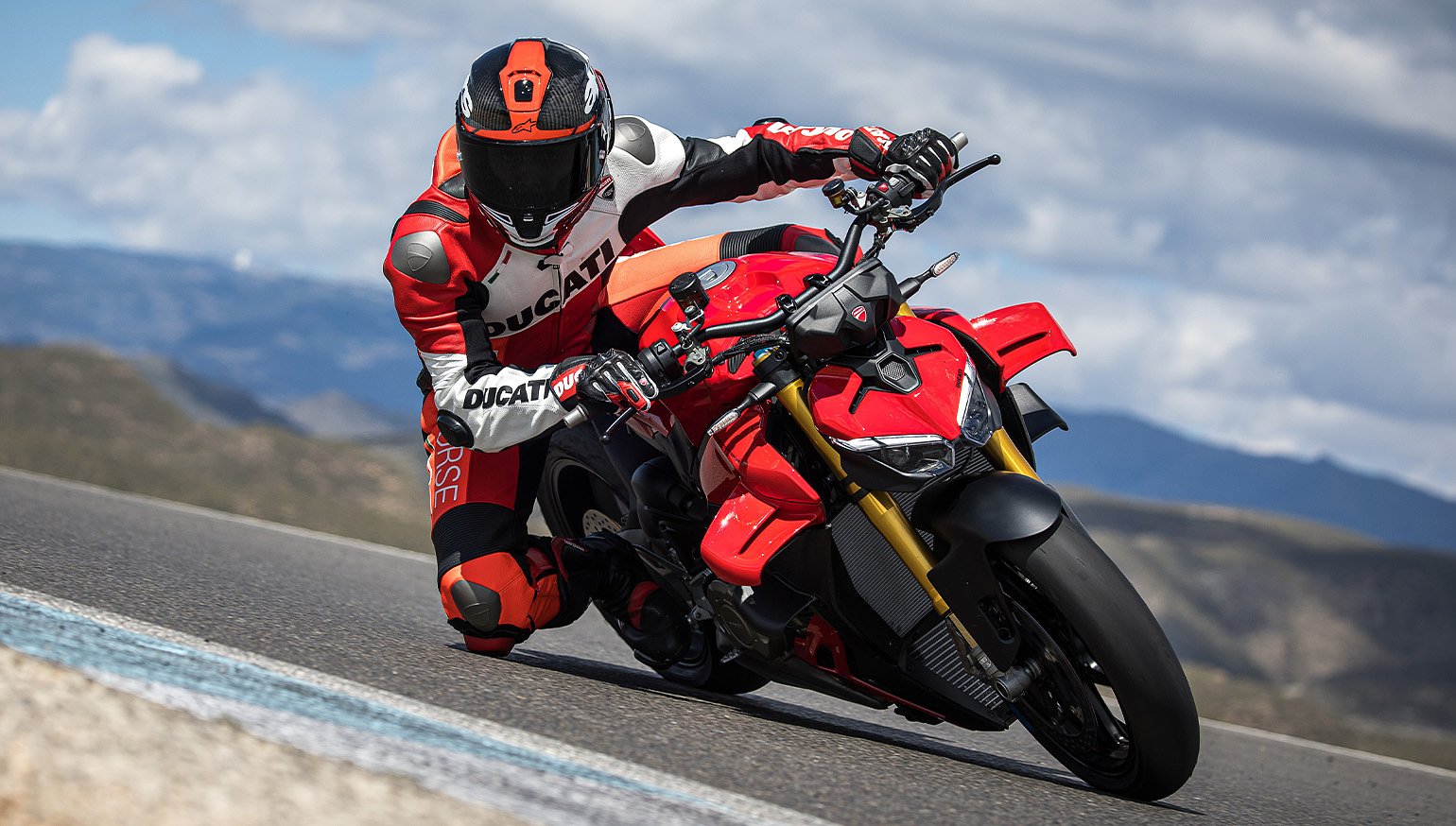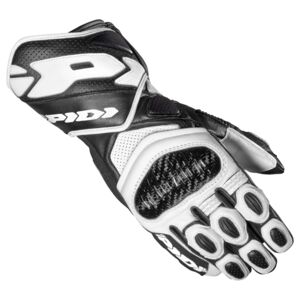Take a sport bike (preferably a high-powered one), strip away its fairings, swap its clip-ons for a handlebar, and what you have is a streetfighter motorcycle. It’s all sport bike performance with no sport bike discomfort. That was also Ducati’s goal for the 2025 Streetfighter V4.
The aptly named super naked is only a half step removed from its superbike cousin, the Panigale V4. It rides like a Ducati sport bike, with acceleration so blistering it should be spelled c-r-i-m-i-n-a-l. It sounds like a sport bike, with an exhaust note the devout Ducatisti would confuse for heaven’s trumpets. It even looks the part, bathed in red and winglets fully spread.
This ‘Fighter may be made for the streets, but accessing its full power is practically impossible on public roads. A fact that Ducati was all too aware of. So, when it was time to host the model’s international press launch, the roads around Almería, Spain, wouldn’t suffice. Only the nearby Andalucia Circuit would do.
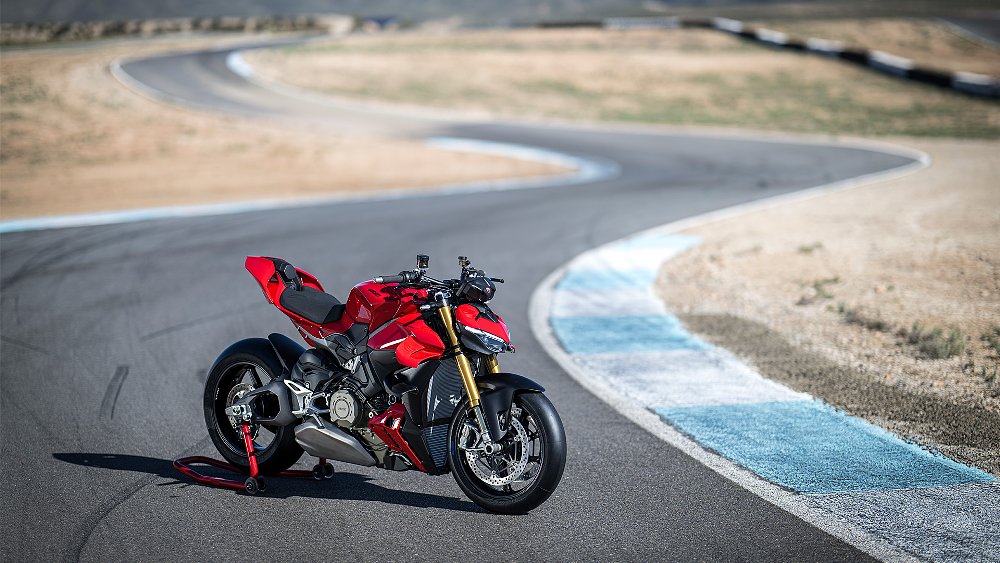
The factory treatment
Fourteen corners comprise the 3.1-mile racecourse, but it’s the 900-meter back straight and fourth-gear turn six that make it a fast track. It’s the double-apex turn five and the fifth-to-second-gear turn 13 hairpin that make it technical. In that way, Andalucia served as the ideal proving ground for the fairing-less superbike. Ducati outfitted the model for the occasion, too.
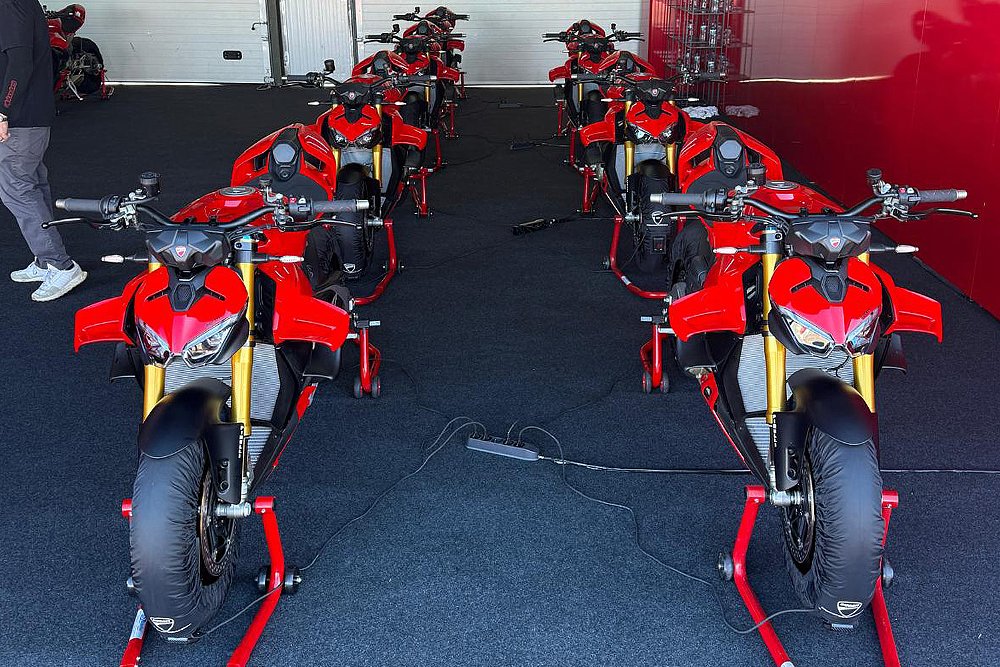
Thirteen mirrorless and plateless Streetfighter V4 Ss rested on front and rear stands, tire warmers hugging their recently mounted Pirelli Diablo Superbike SC1 slicks. The garage, prepped like a MotoGP “box.” I was receiving the factory racing treatment, a feeling only compounded by the fact that I was decked out in Ducati-branded race leathers. I have British Airways to thank for that, as my gear bag eluded their luggage handlers the day before — shoutout to Iberia Airlines for fumbling the transfer thereafter (10/10 experience).
Looking like the Temu version of Marc Márquez but feeling like the real McCoy, I was revved up and raring to go. So were the Streetfighters. Engine after engine sprang to life. A chorus of percussive exhausts echoed down pit lane. I mounted my steed, pulled in the clutch, and dropped the gearbox into first. A bassy growl issued from the underslung pipes as I cracked the throttle and rolled onto the track.
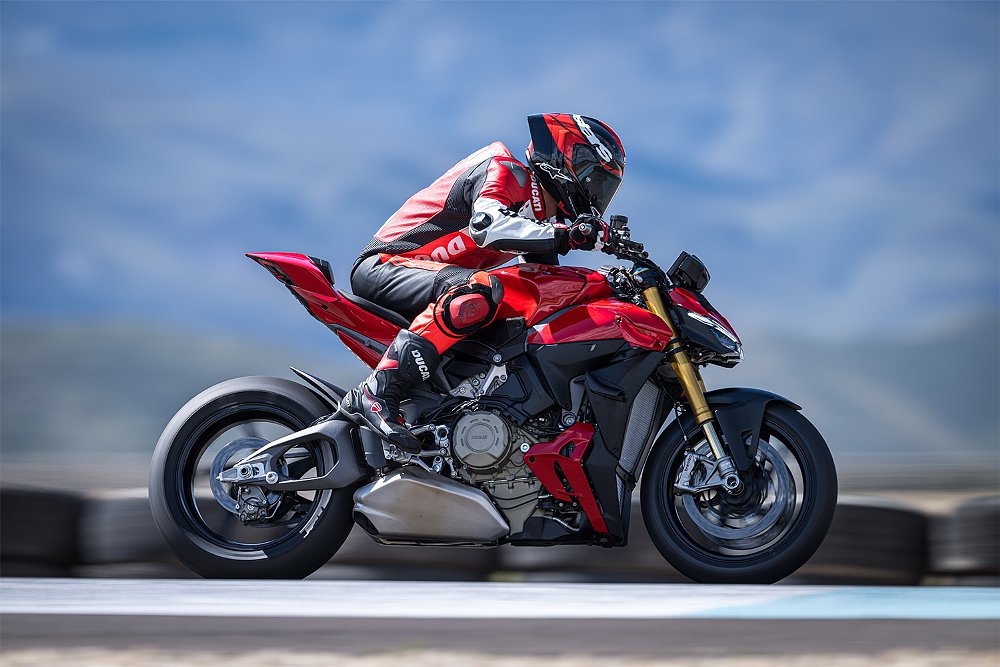
I hadn’t even negotiated turn two and I already learned why Ducati launched the Streetfighter V4 S at the race track. It’s the only place to truly showcase its Desmosedici Stradale engine.
V for velocity
The Streetfighter’s 90-degree V4 retains many of its key specs in 2025. I’m talking about its 81 mm bore, 53.5 mm stroke, and 1,103 cc displacement. Its desmodromic valvetrain, twin-pulse firing order, and counter-rotating crankshaft return, too. New to the Streetfighter is Ducati’s Variable Intake System (VIS), which employs throttle bodies with variable funnel lengths. Equipped with higher lift intake (+0.75 mm) and exhaust (+0.45 mm) camshafts, the Streetfighter V4 produces more power than ever. All while meeting Euro5+ emission standards.
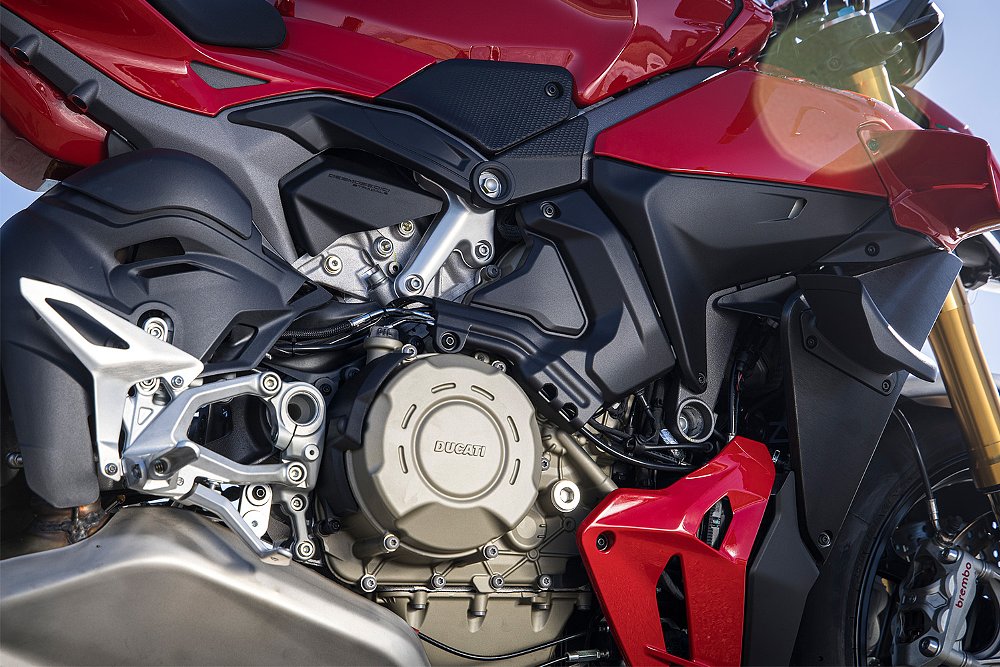
The result is 214 horsepower (at 13,500 rpm) and 89.3 foot-pounds of torque (at 11,250 rpm). At least that’s what the Italian firm lists for the European unit I tested at the international press launch. It’s a different story for the North American model, which produces a claimed 205 horsepower (at 12,650 rpm) and 88.3 foot-pounds of torque (at 11,500 rpm).
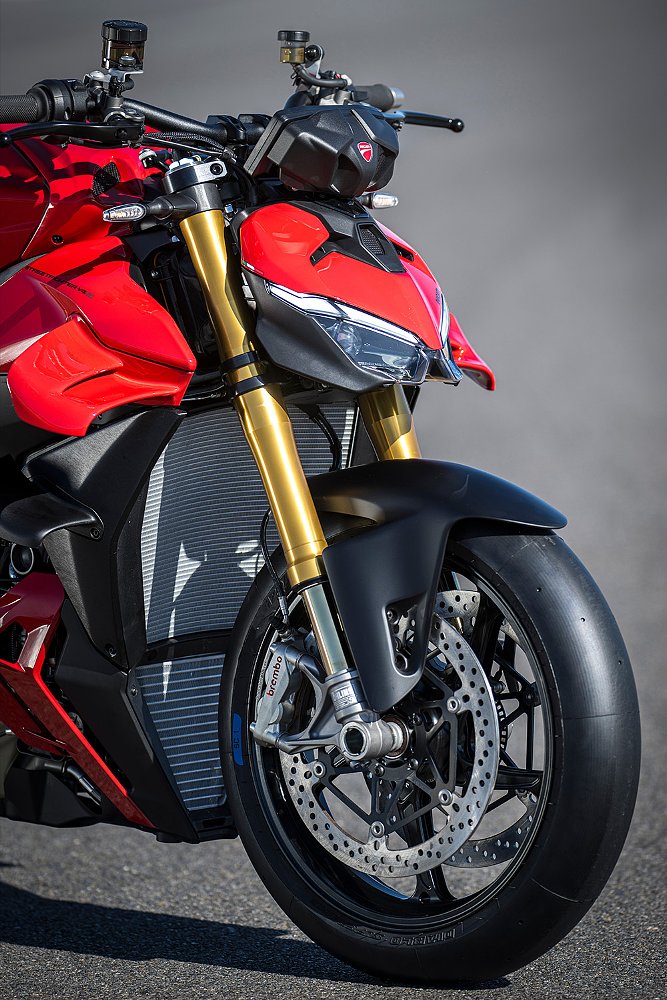
Ducati attributed the discrepancy to U.S. noise emissions standards (no surprise there). Unfortunate as that may be, exploiting the model’s full performance isn’t an easy feat. Even on the track, I left a considerable amount of pony power untapped. That was all the more evident when former Isle of Man TT racers like Lee Johnston and Rennie Scaysbrook blew by me on the nearly one-kilometer-long straight.
Riding any track for the first time requires a few sessions to acclimate to the layout. It required even more to acclimate to the Streetfighter’s power. Unbeknownst to me, I was short-shifting the bike between practically every corner, utilizing only two-thirds of the engine’s rev range. That’s why discovering the model’s top end was eye-opening in the most literal sense. As soon as I surpassed 9,000 rpm, the ‘Fighter hit the afterburners, streaking down the straight in a blur of red and exhaust fumes.
That sensation is a major selling point for Ducati’s super naked. It’s far from its best trait, however. All-out power may win the spec-chart wars, but it's the V4’s usability that makes the difference. Aside from its top-end rush, the engine’s power delivery is largely linear. In most cases, it’s downright friendly. If I forgot to downshift, it still fired off the corner with torque on demand. When I snuck on the throttle at lean, it never sent me wide, holding the line with precise fueling. The Desmosedici doesn’t goad you into high-speed antics. But make no mistake, it’s always ready to light the fuse.
The only bone I can pick with the superbike-derived engine concerns its new Quick Shift 2.0. I had similar complaints for the 2025 Multistrada V2 S. I’m sad to report that the Streetfighter V4 S didn’t address the issue. The system worked as advertised 99% of the time. On occasion, the quickshifter engaged the next gear, unexpectedly cut power, and a split second later, drive returned.
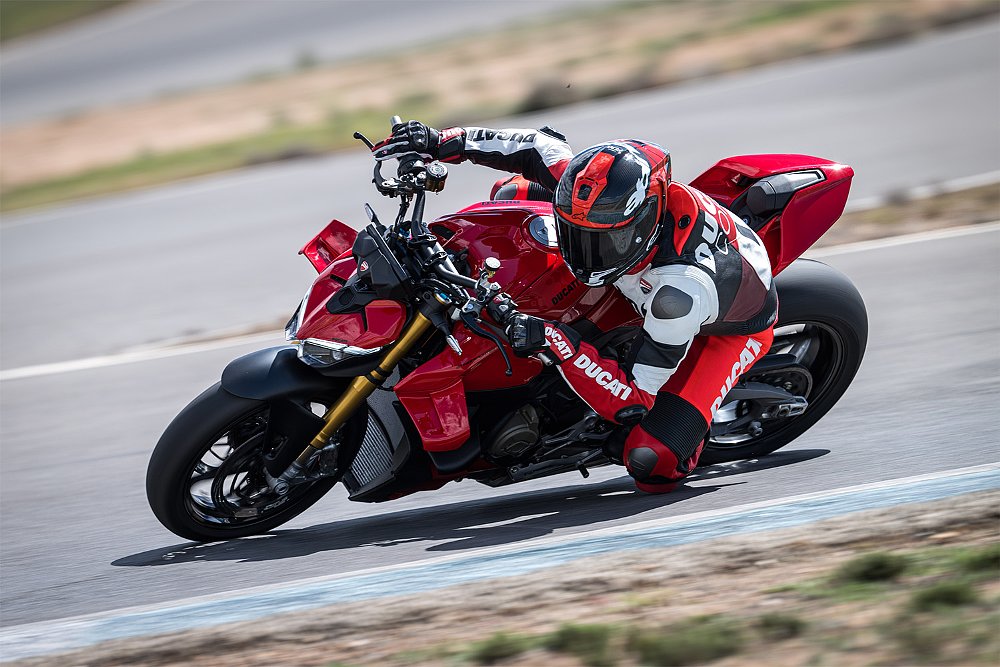
There was no consistency to the hiccups, either. Sometimes, it occurred at full lean. Other times, it happened on the front straight. While such instances were inconvenient on the road (with the Multistrada V2 S), they were far more jarring on the track, where it didn’t just sacrifice the bike’s drive but also its stability. Maintaining that stability is critical for any motorcycle, but it’s especially important for the superbike-turned-super-naked.
Path of most resistance
A higher handlebar may improve the Streetfighter’s riding comfort, but it also introduces instability. Whereas sport bikes place the rider’s weight over the front wheel, a naked bike positions the rider high and in the wind. The addition of speed only makes matters worse. To offset the destabilizing effect, Ducati engineers made minuscule changes to the Panigale V4’s existing chassis. Take the front frame, for instance, which is still 17% lighter and 40% less stiff than the outgoing unit. In Panigale form, the frame sports a 24-degree rake and 3.86-inch trail. Ducati nudges those figures to 24.5 and 3.9 (respectively) for the Streetfighter. Small changes, big differences.
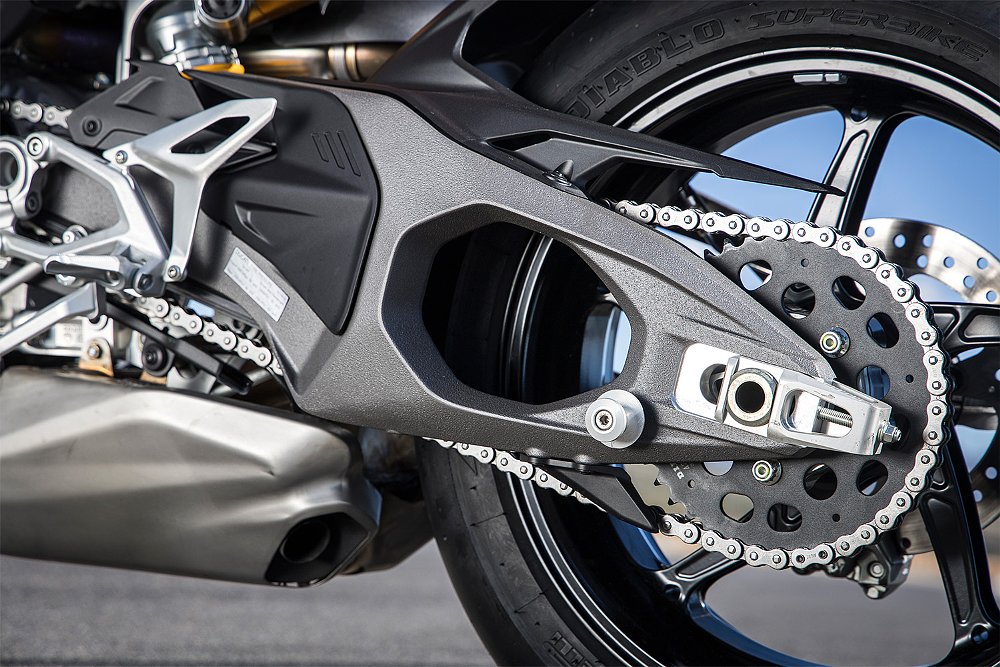
The same theme carries over to the new two-sided swingarm. It’s less rigid (by 43%), but it’s also longer, pushing the Streetfighter’s wheelbase to 59 inches (previously 58.6 inches). The model’s biplane wings contribute to the cause, as well. Ducati states that the winglets produce 99 pounds of downforce at 168 mph, but according to brand reps, the aero is working well before that point, keeping the front wheel earthbound under hard acceleration.
It’s difficult to argue with those claims after spending six sessions aboard the Streetfighter. The only time the front end unexpectedly took flight was at the turn-13 exit, where heavy acceleration over a slight rise hovered the wheel off the pavement. Otherwise, the ‘Fighter stayed grounded. Its chassis was just as composed at corner entry and just as planted mid-turn. That doesn’t mean the Duc was unflappable in all instances.
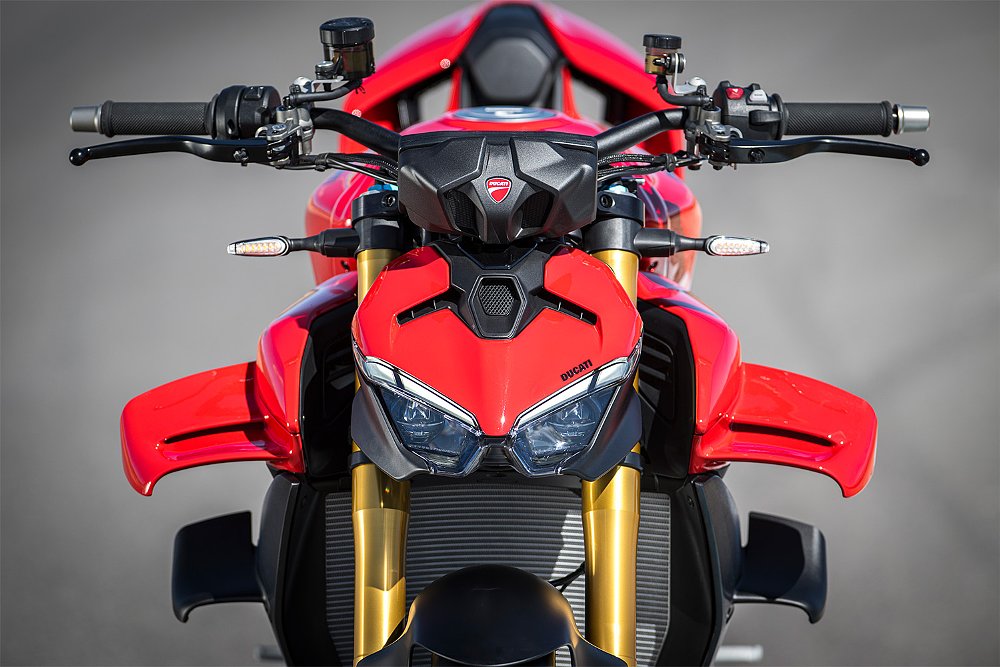
When it comes to naked bikes, the question isn’t, “how fast can it go?” The question is, “how fast can it go with me still hanging on?” At least that's what I pondered as the wind force started prying my helmet away from the Streetfighter’s tank at 140 mph. Even a minor disturbance influenced the Streetfighter’s stability at those speeds.
In one instance, I simply untucked my foot from the gear shifter. In the process, I inadvertently shifted my knee outward, catching the wind and introducing a high-speed wobble. Let’s just say I kept my movements short and compact thereafter. Ducati’s chassis alterations are largely effective, but the Streetfighter is still a naked bike. What you gain in ergonomic comfort, you give up in wind protection.
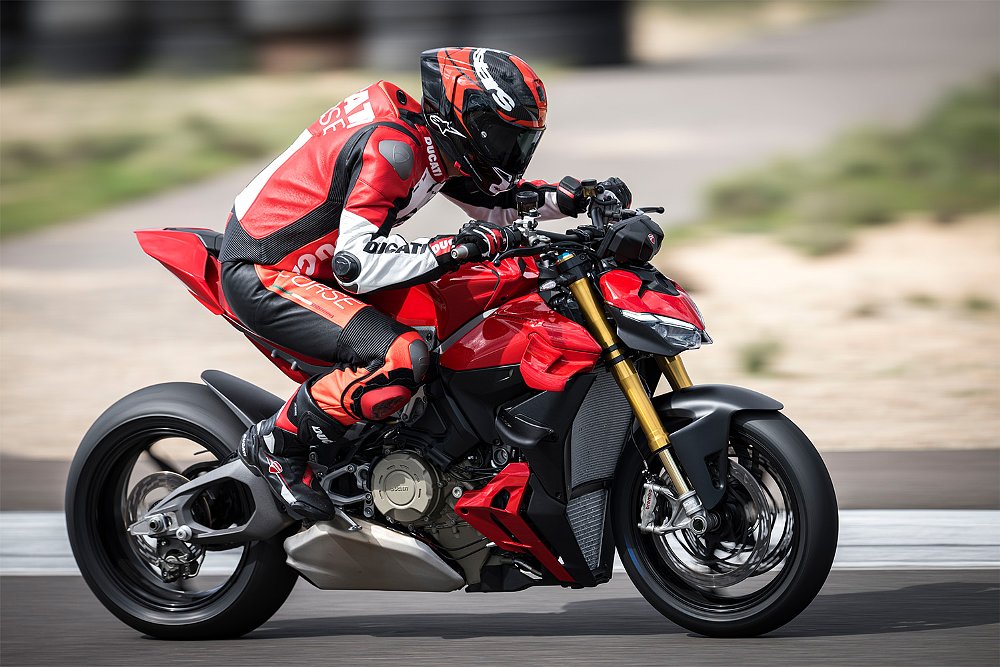
Stop and go
Pick a rider aid, any rider aid, and the odds are the Streetfighter V4 S has it. There are three power settings (High, Medium, and Low) and eight levels of traction control and wheelie control. You can fine-tune engine braking and slide control parameters. Even the semi-active Öhlins Smart-EC 3.0 suspension offers four options (Track, Dynamic, Comfort, and Low Grip). Add to that launch control and a pit limiter, and you have my analysis paralysis firing on all cylinders.
Lucky for me, the four ride modes (Race, Sport, Road, and Wet) pre-populate each field with the appropriate settings (although each setting is customizable). Testing the Streetfighter on track further limited those choices to Sport and Race. Hal-le-lu-jah. I’ve said this before, but it bears repeating: I’m no racer. I can’t tell you the difference between 10 and 12 clicks of front-end compression. I can’t detect a two-psi drop in the rear tire. What I can distinguish is when a bike accelerates faster and brakes harder. In other words, the two major differences between the Sport and Race modes.
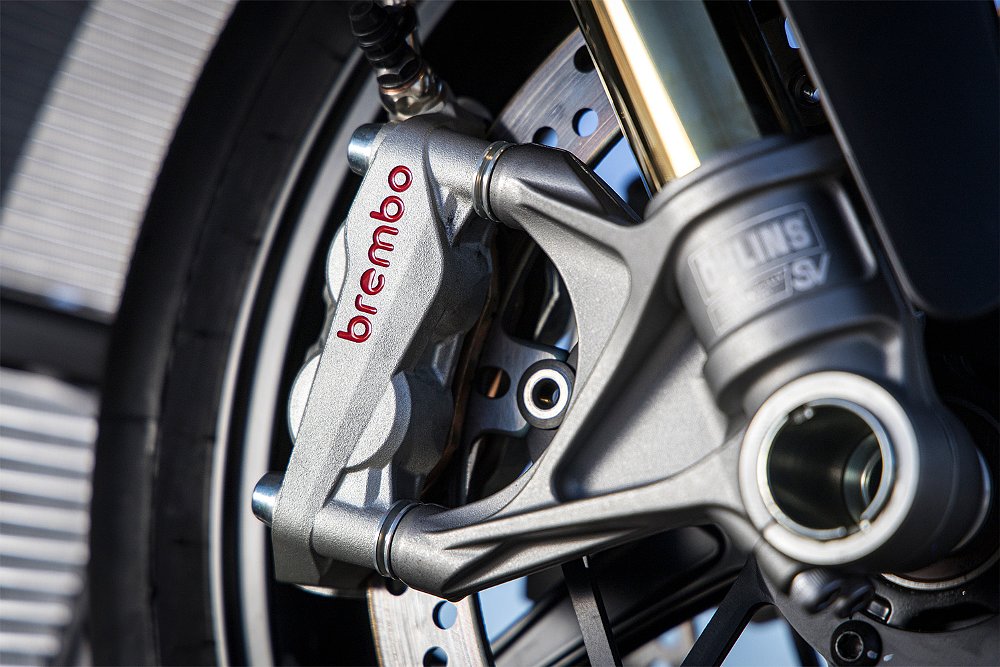
The V4 is already brutally fast in Sport. It’s utterly ballistic in Race. Both modes offered finesse at the throttle tube, but Race delivered that much more punch when pinned, firing me from point A to point B at what felt like 1.5x video speed. Stopping power is all the more critical at such a pace, but I personally preferred Sport mode’s braking setup. It all came back down to stability.
In plain speak, Ducati’s Race eCBS feature is a linked braking system. When the rider actuates the front brake lever, the system also engages the rear caliper. It not only magnifies the bike’s stopping force but also mitigates front-end load transfer. That, in turn, preserves both the rear wheel’s contact patch and the bike’s overall stability. For someone like me — someone who never uses the rear brake — it’s a godsend.
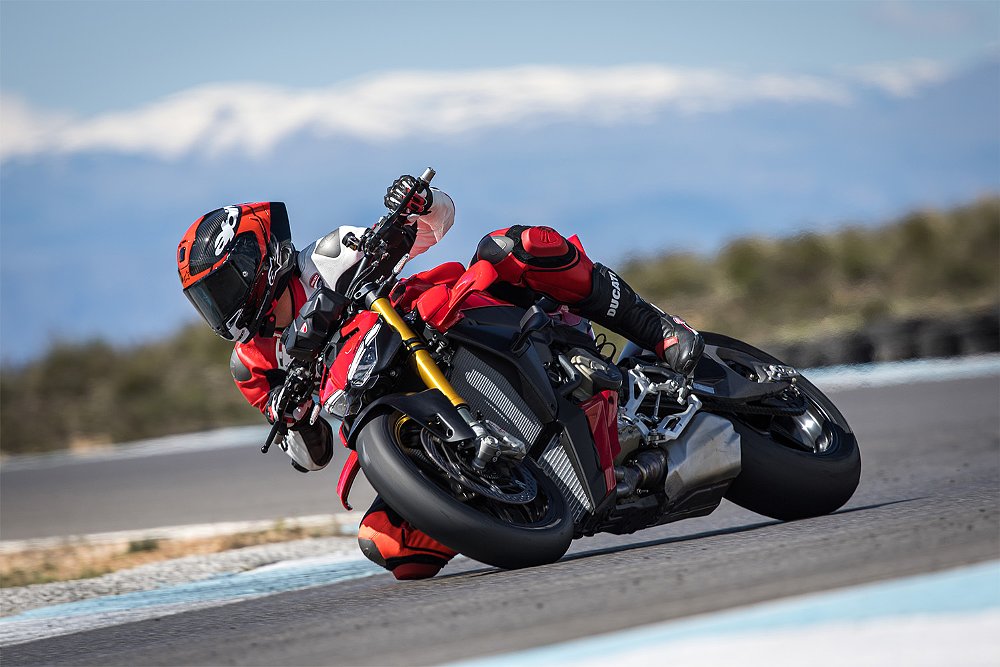
But, Race eCBS is one of those features that’s only noticed when it’s absent. Much of the time, I simply marveled at the Brembo Hypure front braking system, which seemed to harness endless speed-scrubbing capacities. Only after switching to Race mode, and the lowest Race eCBS setting, did I realize how much I’d come to rely on the safety aids. It was immediately apparent at the downhill braking zones of turns eight and nine, where the rear wheel squiggled across the pavement. It was only reinforced when I overcooked my entry at turns 13 and 14. It probably goes without saying, but I cranked Race eCBS back up the very next session.

It’s that mix of approachability and capability that makes the Streetfighter suitable for intermediate track riders and former racers alike. The Desmosedici engine is tractable yet terrifying. The electronically controlled Öhlins suspension can be compliant or responsive. Race eCBS can lend a helping hand or get out of your way. The Streetfighter V4 S can be many things, it simply leaves the decision up to the rider.
Fight on
Everything in motorcycling comes down to compromise. You can have superbike performance, but you can’t be comfortable at the same time. No matter what you choose, there’s a trade-off. It’s no different for the Streetfighter V4 S. Ducati just does its darndest to offset those compromises. The super naked is inherently less stable than the Panigale V4, but geometry and winglets keep it planted. Its engine is down on power, but only marginally. Even the tech suite is on par with its superbike relative.
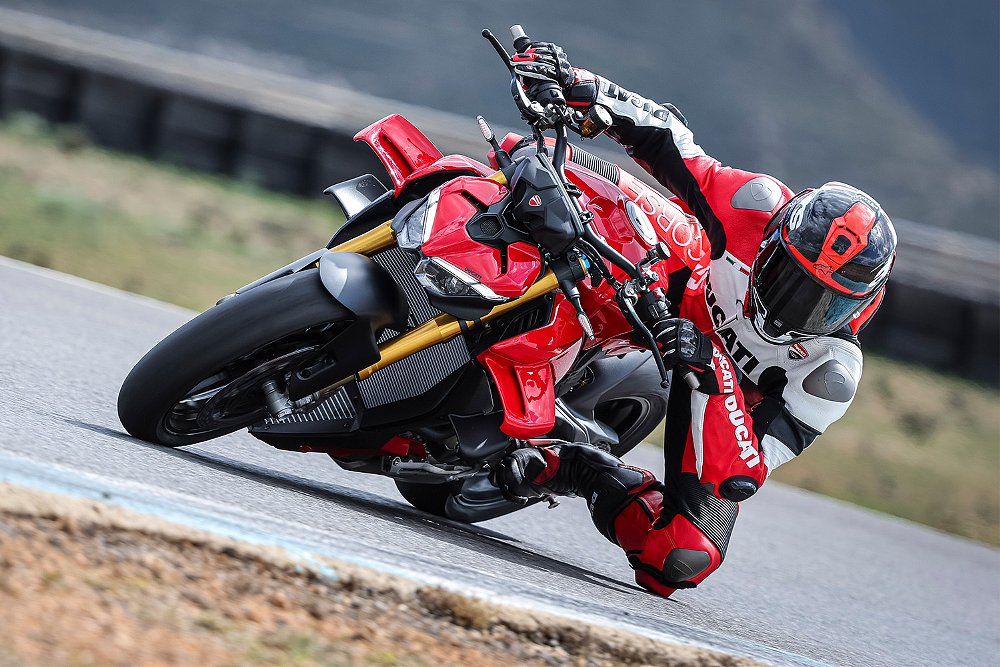
The Streetfighter may have performed admirably at the Andalucia Circuit, but its true home is on the street. (It rides like a sport bike. Well, as much as the wind allows it to.) That’s why most customers will enjoy the bike on public roads, where rider comfort isn’t a complete aero liability. Yes, the V4 S can carve up a track, but as its name suggests, this ‘Fighter strikes a better balance between sport bike performance and naked bike comfort out on the street.
| 2025 Ducati Streetfighter V4 S | |
|---|---|
| Price (MSRP) | $29,295 ($23,995 for non-S) |
| Engine | 1,103 cc, liquid-cooled, 16-valve, V-four |
|
Transmission, final drive |
Six-speed, chain |
| Claimed horsepower | 205 @ 12,650 rpm |
| Claimed torque | 88.3 foot-pounds @ 11,500 rpm |
| Frame | Aluminum twin-spar |
| Front suspension | Öhlins NPX25/30 43 mm fork, adjustable for spring preload, electronically adjustable for compression and rebound damping; 4.9 inches of travel |
| Rear suspension | Öhlins TTX36 shock, adjustable for spring preload, electronically adjustable for compression and rebound damping; 5.1 inches of travel |
| Front brake | Brembo Hypure four-piston calipers, 330 mm discs with ABS |
| Rear brake | Brembo two-piston caliper, 245 mm disc with ABS |
| Rake, trail | 24.5 degrees, 3.9 inches |
| Wheelbase | 59 inches |
| Seat height | 32.5 inches |
| Fuel capacity | 4.2 gallons |
| Tires | Pirelli Diablo Rosso IV Corsa, 120/70ZR17 front, 200/60ZR17 rear |
| Claimed weight | 421 pounds (no fuel) |
| Available | April 2025 |
| Warranty | 24 months |
| More info | ducati.com |




